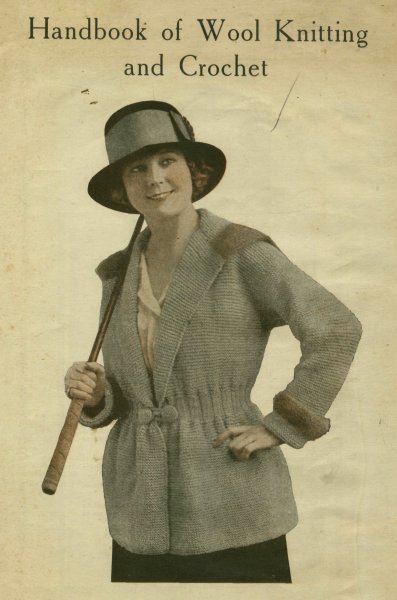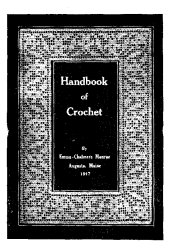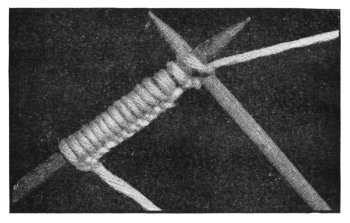Handbook of Wool Knittingand Crochet

Published by
Needlecraft Publishing Company
Augusta, Maine
1918
12c

12c
You can crochet the most fascinatingthings imaginable if you have this
Handbook of Crochet
By Emma Chalmers Monroe
This book is equally appreciated by beginner or expert. It containsmost valuable information and instructions for everyone who crochetsor wishes to learn to do this beautiful work. It embodies a verycareful selection of designs; and, from the simplest to the most ornate,every successive step is explained and illustrated so fully that perfectresults are a certainty.
It describes the making of the newest designs for the ever popular use ofcrochet and gives instructions and patterns for Edgings, Borders, Scarf-Ends,Insertions, Yokes, Lunch-Sets, Doilies, etc.
The book has twenty-eight pages (size 7×10 inches) and 44 illustrations.It is printed on a fine quality of paper with the cover in colors.
Your copy of Emma Chalmers Monroe's Handbook of Crochet will besent you, prepaid, upon receipt of 12 cents, stamps or coin. It can beobtained only from us.
Needlecraft
Augusta—Maine
Handbook of Wool Knittingand Crochet
A Lesson in Knitting
The first thing to be done in knitting is to cast on or, as it issometimes called, to "set up the foundation." (Figure1). There are several methods for this, the following beingthat preferred and generally used by the writer: Leavea spare end of thread, sufficient for the number of stitchesyou wish to cast on, lying toward the left, the spool orball from which the working-thread is drawn being at theright. Lay the thread between the little finger and thethird of the left hand; bring the working-thread acrossthe palm of the hand, around the thumb and backbetween the forefinger and second finger; bend theforefinger over this thread (which passes between it andthe second finger), pass it under the thread which crossesthe palm of the hand, and then draw the forefinger back,or straighten it, which will give you a loop with crossedthreads. Put the needle under the lower part of thisloop, which draws from the ball, bring the working-thread(or ball-thread) around the point of needle from rightto left, as in plain knitting, draw it back through the loop,slip off the latter, and draw up the left thread. Then proceedto make the crossed loop and knit it off in the sameway for the next and following stitches. The whole operationis very simple, although the instructions seem long becauseexplicit. Take your needle and yarn or thread andfollow them through carefully, and you will very soon ma
